Choosing the wrong medical display can hide crucial diagnostic details and waste precious hospital funds. The complex specifications can feel overwhelming. Following these expert tips will guide your purchase decisions.
A successful medical display purchase hinges on ten key factors. These include resolution, DICOM compliance, brightness, color accuracy, connectivity, ergonomics, longevity, certifications, system integration, and the overall balance of cost and performance.

Purchasing medical displays is a high-stakes decision that directly impacts clinical outcomes and departmental budgets. It is not like buying a standard office monitor. Each feature serves a critical function, from ensuring diagnostic accuracy1 to protecting the well-being of clinicians. A thoughtful approach to procurement2 involves looking beyond the initial price tag to understand how a display will perform in its intended environment over its entire service life. We will now walk through the ten most important considerations to help you make a confident and informed choice.
1. Prioritize Resolution and Grayscale Accuracy for Diagnostics
Can your clinicians see the finest details in a scan? A low-resolution display can obscure subtle pathologies, leading to diagnostic uncertainty. The right resolution makes every detail visible.
A display’s resolution and grayscale performance directly determine the visibility of critical image details. This makes them the highest priority when selecting monitors for diagnostic radiology.
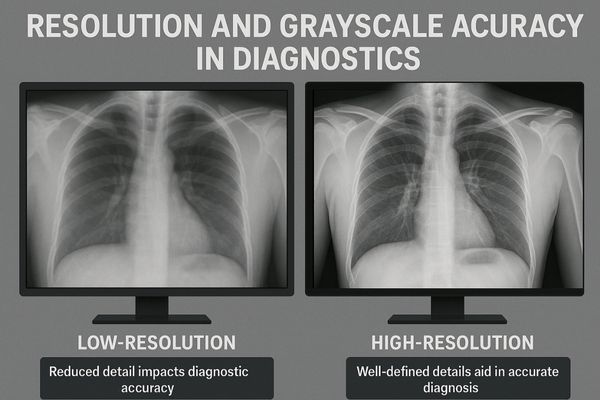
In diagnostic imaging, resolution refers to the number of pixels on the screen, typically measured in megapixels (MP). Grayscale accuracy refers to the monitor’s ability to display subtle shades of gray correctly. Together, these two factors form the foundation of diagnostic confidence3. A higher resolution allows for the clear visualization of small anatomical structures without constant zooming, which can disrupt the radiologist’s focus. For example, mammography requires at least a 5MP display to reliably detect microcalcifications. Grayscale performance, governed by the monitor’s bit depth, determines how many distinct shades of gray can be shown. A superior display can render thousands of shades, revealing minute variations in tissue density that would be invisible on a consumer-grade screen. Products like the MD51CHY – 34" 5MP Diagnostic Monitor for X-ray Imaging are engineered specifically to deliver this combination of high resolution and nuanced grayscale detail, providing the clarity needed for definitive interpretations.
2. Ensure DICOM Compliance for Consistent Image Presentation
An image appears correct on one monitor but looks different on another. This inconsistency creates diagnostic doubt and a risk of error. DICOM compliance is the only way to guarantee uniformity.
DICOM compliance is essential for ensuring consistent medical image presentation across all devices and hospital systems. This standardization reduces diagnostic errors that arise from display discrepancies.
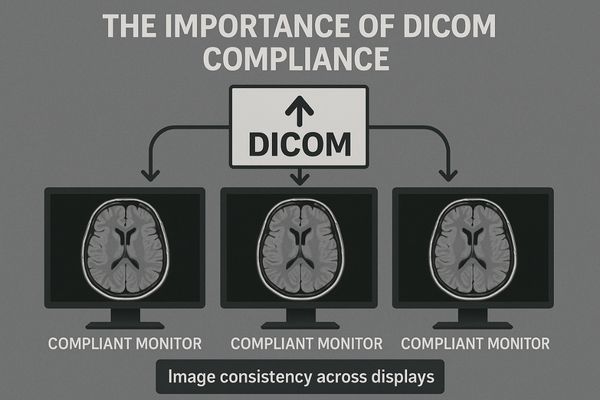
DICOM Part 144 is the global standard for grayscale display function. Its purpose is to ensure that a medical image looks the same on any compliant monitor, anywhere in the world. This is called perceptual consistency. A non-compliant display’s brightness can fluctuate, altering how grayscale values are presented and potentially hiding or creating visual artifacts that could be mistaken for pathology. A true medical-grade monitor5 ensures this does not happen. It uses internal sensors to continuously measure its brightness and automatically adjust it to match the DICOM standard. This calibration process maintains diagnostic integrity throughout the monitor’s life. When a hospital equips all its workstations, from radiology reading rooms to surgical suites, with DICOM-compliant displays like the MD26C – 24" Diagnostic Monitor, it creates a reliable imaging ecosystem. This allows clinicians to trust what they see, leading to more confident and collaborative decision-making.
| Feature | Consumer Monitor | DICOM Compliant Monitor |
|---|---|---|
| Grayscale Standard | Uncalibrated | Adheres to DICOM Part 14 GSDF |
| Brightness Stability | Fluctuates with age/temp | Constantly monitored and stabilized |
| Quality Assurance | Manual, subjective checks | Automated, software-driven QA |
| Diagnostic Use | Not approved | Certified for clinical diagnosis |
3. Evaluate Brightness and Contrast for Various Clinical Environments
The bright lights of an operating room can wash out a standard screen. Conversely, a display that is too bright can cause eye strain in a dark reading room. Proper brightness is key.
A display’s brightness and contrast levels must be appropriate for the intended clinical environment. This ranges from dark reading rooms to brightly lit operating theaters to ensure constant readability.

Brightness, measured in candelas per square meter (cd/m²), and contrast ratio6 are not one-size-fits-all specifications. The ideal levels depend entirely on the ambient lighting of the use case. A radiology reading room is typically kept dark to maximize the visibility of subtle grayscale details. Here, a display with a calibrated brightness of around 400-500 cd/m² and a high contrast ratio is ideal for reducing eye strain. In contrast, an operating room is an intensely lit environment. A surgical display must have a much higher peak brightness, often exceeding 800 cd/m², to produce a clear, vibrant image that is not washed out by the overhead surgical lamps. The screen should also feature an effective anti-glare coating7 to minimize reflections. Selecting a monitor like the MS275P – 27" 4K Surgical Monitor ensures that the surgical team has a consistently clear view, which is essential for procedural accuracy and safety.
4. Check Color Accuracy for Pathology and Surgical Applications
A pathologist reviews a digital slide, but the stain colors appear muted. This poor color fidelity can lead to an incorrect assessment. Accurate color rendering is not a luxury; it is a necessity.
Clinical environments like digital pathology and endoscopic surgery demand precise color reproduction. This is essential for accurately distinguishing tissue types and clearly defining lesion boundaries.
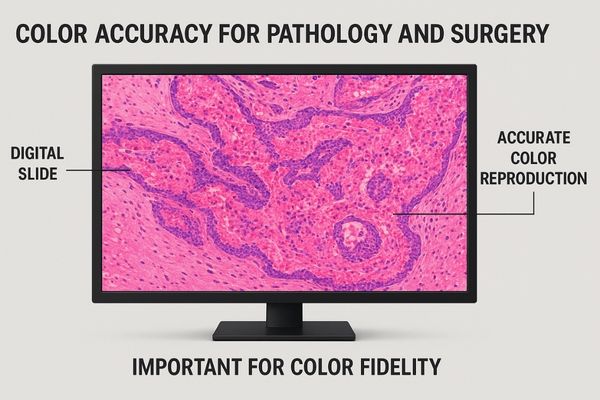
While radiology is dominated by grayscale, many other medical disciplines depend on color. In digital pathology, specific chemical stains are used to highlight different cellular structures. The exact hue and saturation of these colors provide critical diagnostic information. A display must be able to reproduce these colors with high fidelity. Similarly, during endoscopic surgery, the surgeon relies on the monitor to show the true colors of internal tissues, distinguishing healthy tissue from inflamed or abnormal areas. This requires a display with a wide color gamut8 (the range of colors it can produce) and, more importantly, excellent color accuracy9. This means the display has been calibrated at the factory to ensure colors are rendered correctly according to standards like sRGB. Investing in a display with proven color performance, such as the MD50C – 5MP Color Mammography Monitor, provides clinicians with the visual confidence needed for precise diagnostic and surgical work.
5. Confirm Multi-Input Support for Diverse Imaging Modalities
Clinicians waste precious time switching between different monitors to view CT, MRI, and ultrasound images. This constant toggling is inefficient. A display with multiple inputs can solve this problem.
Displays offering multiple input options like DisplayPort and HDMI can seamlessly integrate images from various sources like CT, MRI, and ultrasound. This minimizes device switching and boosts workflow efficiency.
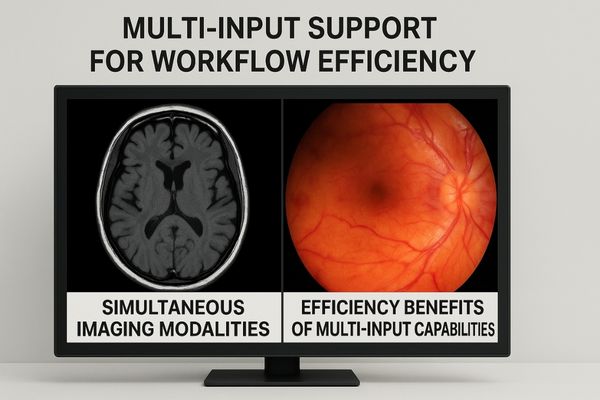
Modern patient diagnosis often requires the correlation of data from multiple imaging modalities. A clinician may need to compare a live endoscopic video feed with a patient’s pre-operative MRI scan. A display with a single input would force them to use separate monitors, cluttering the workspace and disrupting their focus. A monitor equipped with multiple inputs10 (e.g., DisplayPort, HDMI, DVI) and features like Picture-in-Picture11 (PIP) or Picture-by-Picture (PBP) offers a much more elegant solution. It allows different video sources to be displayed simultaneously on a single screen. This creates a unified visual workspace where clinicians can view and compare images from different systems side-by-side. This integrated approach not only streamlines the workflow but also facilitates a more holistic understanding of the patient’s condition. A large-format display like the MS550P – 55" 4K Surgical Monitor is ideal for this, serving as a central information hub in the operating room or a large consultation room.
6. Assess Ergonomic Design to Reduce Reader Fatigue
Radiologists spend hours each day in front of screens, leading to neck strain and eye fatigue. An uncomfortable workstation degrades performance and well-being. Ergonomics are part of the solution.
An ergonomic and adjustable design helps reduce the neck and eye strain associated with long reading sessions. This directly improves clinician comfort, focus, and long-term productivity.

The physical comfort of a clinician is directly linked to their diagnostic performance. A workstation that causes physical strain will inevitably lead to a loss of focus and efficiency over a long workday. Ergonomics should be a key consideration in any display purchase. A high-quality medical display should feature a fully adjustable stand that allows for changes in height, tilt, swivel, and pivot. This enables each user to position the screen at the optimal height and angle for their posture, reducing musculoskeletal strain. Beyond physical adjustments, visual ergonomics12 are also critical. Features like flicker-free backlight technology13 eliminate the imperceptible screen flicker that is a major cause of eye strain and headaches. Additionally, built-in ambient light sensors can automatically adjust screen brightness to match room conditions, preventing unnecessary eye fatigue. Even a basic diagnostic model like the MD10C – 1MP Diagnostic Monitor should provide these fundamental ergonomic features to support a healthier and more productive reading environment.
| Ergonomic Feature | Benefit | Impact on Productivity |
|---|---|---|
| Fully Adjustable Stand | Reduces neck and back strain | Allows for longer periods of focused work. |
| Flicker-Free Technology | Minimizes eye fatigue and headaches | Improves visual comfort and sustained concentration. |
| Anti-Glare Screen | Prevents distracting reflections | Ensures image clarity without visual strain. |
| Low Blue Light Mode | Reduces a specific spectrum of eye-straining light | Makes late ays or on-call sessions more comfortable. |
7. Consider Longevity and Calibration Capabilities
A new display looks great, but its brightness and accuracy fade over time. Frequent replacements are costly and disruptive. Look for a monitor built to last and maintain its performance.
Displays equipped with robust hardware or software calibration tools maintain stable performance over their lifespan. This reduces the frequency of manual maintenance and lowers the total cost of ownership.
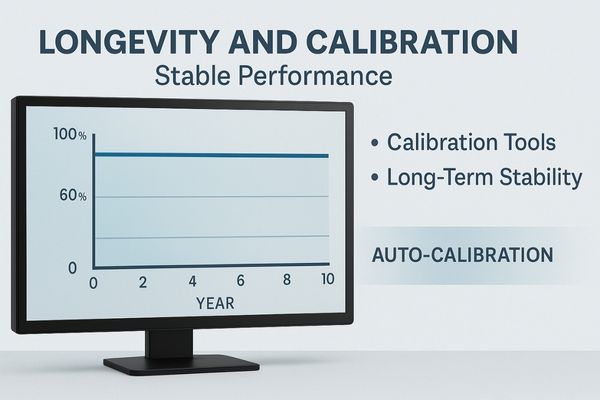
A medical display is a long-term investment. Its value is measured not just by its initial performance but by its ability to maintain that performance for many years. All displays experience a gradual decrease in brightness over time. However, medical-grade displays are designed to manage this degradation. They use high-quality, long-lasting components and often have a high Mean Time Between Failures (MTBF)14 rating. More importantly, they feature advanced calibration capabilities. Some use software that works with an external sensor to recalibrate the display periodically. Higher-end models feature a built-in front sensor that can run automated self-calibration checks without any human intervention. This ensures the monitor remains DICOM compliant15 year after year. A model with advanced calibration, like the MD120C – 12MP High-Precision Diagnostic Monitor with AI Calibration, offers peace of mind. It guarantees long-term performance stability, protecting the hospital’s investment and reducing the workload for the IT and medical physics teams.
8. Verify Compliance with Safety and Environmental Standards
A procurement committee rejects a monitor because it lacks the necessary certifications. This oversight wastes time and forces a restart of the purchasing process. Always verify compliance before buying.
Displays certified to key standards like CE, RoHS, or Energy Star are proven to be safe and eco-friendly. This verified compliance simplifies the hospital’s procurement approval process.

Medical equipment is subject to strict regulatory oversight. Compliance with safety and environmental standards is not optional; it is a fundamental requirement for any device used in a clinical setting. These certifications provide objective, third-party verification that a product meets established benchmarks for safety, performance, and environmental responsibility. Key standards to look for include CE marking16 (indicating compliance with health and safety standards in the European Economic Area), FCC (regulating electromagnetic interference in the US), and RoHS (restricting the use of hazardous substances). Environmental certifications like Energy Star17 indicate superior energy efficiency, which helps reduce operational costs and a hospital’s carbon footprint. Choosing a product that is pre-certified, such as the [MS270P](https://reshinmonitors.com/ms270p-fhd-surgical-display/ "*MS270P") – 27" FHD Surgical Display**, streamlines the procurement process. It gives the purchasing committee the confidence that they are acquiring a product that is not only clinically effective but also safe and responsibly manufactured.
9. Examine Network and System Compatibility for Seamless Integration
A hospital’s IT team spends days trying to get a new display to work with the existing PACS software. This compatibility issue causes project delays and frustration. This can be easily avoided.
Good compatibility with hospital networks and major PACS platforms ensures a smooth, plug-and-play system deployment. This is crucial for avoiding interoperability issues and reducing long-term maintenance burdens.
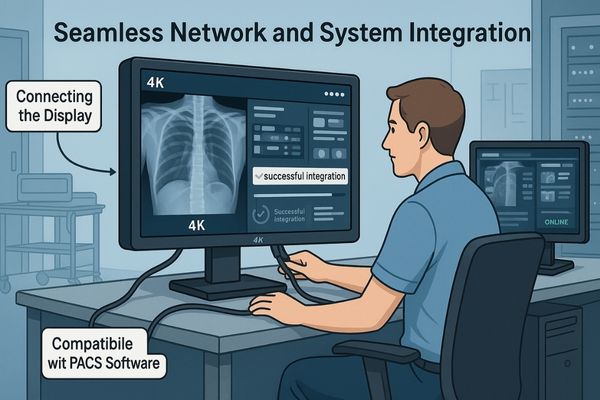
A medical display is an endpoint in a complex hospital IT ecosystem. For it to function correctly, it must integrate seamlessly with existing hardware and software platforms. Before purchasing, it is critical to verify compatibility on several levels. The display must support the physical video connections of the workstations it will be used with. Its driver and control software must be compatible with the hospital’s standard operating system. Crucially, its remote Quality Assurance (QA)18 and calibration software must be able to communicate with the hospital’s central PACS or RIS server. This network capability allows the IT department to manage and monitor the performance of every display in the fleet from a central console, which is a massive efficiency gain. By selecting a monitor that has been tested and validated for use with major PACS vendors19, like the MS430PC – 43" 4K Surgical Monitor, hospitals can ensure a trouble-free deployment and a more stable, manageable imaging environment.
10. Balance Cost with Performance for Optimal Value
The cheapest display seems like a good deal, but it fails after two years. The cost of replacement and downtime quickly erases any initial savings. The best value is not always the lowest price.
Achieving the best value involves carefully balancing the initial cost with the display’s clinical performance and expected lifespan. This ensures all clinical requirements are met while reasonably controlling procurement expenses.

When evaluating the cost of a medical display, it is essential to look at the Total Cost of Ownership (TCO)20, not just the upfront purchase price. TCO provides a more complete financial picture by including factors like energy consumption, maintenance requirements, the cost of calibration, and the product’s expected lifespan. A cheaper, consumer-grade monitor might save money initially, but it will likely have higher energy costs, require frequent manual checks, and fail much sooner than a medical-grade device. The cost of downtime and replacement can quickly exceed the initial savings. The optimal choice is a display that provides the necessary clinical performance and reliability21 at a reasonable price point. A durable, efficient workhorse monitor like the MS220S – 22" FHD Endoscopic Monitor represents excellent value. It meets all the necessary clinical standards for its intended use case and is built to provide reliable service for many years, resulting in a lower TCO and a smarter long-term investment.
Conclusion
A successful purchase balances clinical need with long-term value. By focusing on performance, compliance, and total cost of ownership, you ensure a sound investment in your hospital’s diagnostic capabilities.
📩 Want guidance on making cost-effective yet high-performing medical display purchases? Contact Martin at martin@reshinmonitors.com for expert advice from Reshin.
-
Understanding diagnostic accuracy is crucial for making informed decisions about medical displays that affect patient care. ↩
-
Exploring procurement best practices can help ensure you choose the right medical displays for your clinical needs. ↩
-
Understanding diagnostic confidence is crucial for improving imaging practices and ensuring accurate diagnoses. ↩
-
Understanding DICOM Part 14 is crucial for ensuring consistent medical imaging across different displays, enhancing diagnostic accuracy. ↩
-
Exploring the features of medical-grade monitors can help you appreciate their role in maintaining image quality and diagnostic integrity. ↩
-
Understanding contrast ratio is crucial for selecting displays that enhance visibility and reduce eye strain in various environments. ↩
-
Exploring the benefits of anti-glare coatings can help you choose displays that minimize reflections and enhance clarity in bright settings. ↩
-
Exploring the significance of a wide color gamut can enhance your knowledge of how it impacts medical imaging quality and outcomes. ↩
-
Understanding color accuracy is crucial for medical professionals to ensure precise diagnostics and effective treatment. ↩
-
Exploring this resource will reveal how multiple inputs enhance workflow and efficiency in medical settings. ↩
-
This link will provide insights into how Picture-in-Picture enhances the viewing experience for clinicians. ↩
-
Exploring ergonomic practices can enhance clinician comfort and improve diagnostic performance, leading to better patient outcomes. ↩
-
Understanding flicker-free technology can help you choose displays that minimize eye strain, enhancing comfort during long work hours. ↩
-
Understanding MTBF can help you choose reliable medical displays that ensure long-term performance and reduce maintenance costs. ↩
-
Exploring DICOM compliance is crucial for ensuring that medical displays meet industry standards for image quality and interoperability. ↩
-
Understanding CE marking is crucial for ensuring compliance with health and safety standards in medical devices. ↩
-
Exploring Energy Star certification can help you choose energy-efficient medical devices, reducing costs and environmental impact. ↩
-
Understanding QA in medical displays is essential for ensuring accurate and reliable imaging in healthcare settings. ↩
-
Exploring major PACS vendors helps hospitals choose compatible systems for seamless integration and improved efficiency. ↩
-
Understanding TCO is crucial for making informed decisions on medical displays, ensuring long-term savings and efficiency. ↩
-
Exploring this topic helps ensure you choose displays that meet clinical standards, enhancing patient care and operational efficiency. ↩

